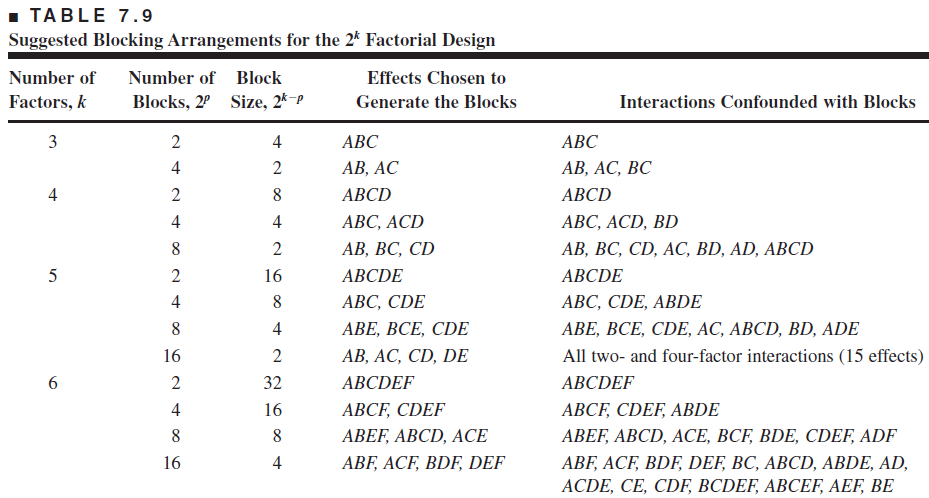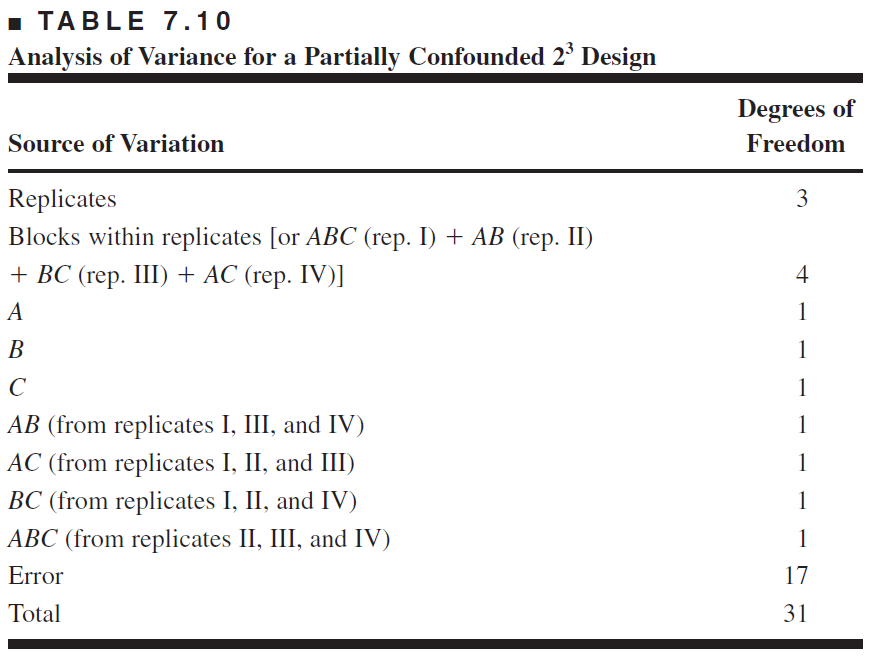Chapter 7
(AST301) Design and Analysis of Experiments II
7 Blocking and Confounding in the
7.1 Introduction
Blocking is a technique for dealing with controllable nuisance variables
Two cases are considered
Replicated designs
Unreplicated designs
7.2 Blocking a replicated
In many situations, it is impossible to perform all the runs in a
The design technique used in these situations is blocking.
Consider
If blocks of size
The method of analyzing the factorial design, where each replicate is run in one of the blocks, has already been discussed (in Chapter 5)
Experimental units are randomly assigned to treatments within each block.
EXAMPLE 7.1
Consider the chemical process experiment described in Section 6.2
Suppose that only four experimental trials can be made from a single batch of raw material.
Therefore, three batches of raw material will be required to run all three replicates of this design.
Table 7.1 shows the design, where each batch of raw material corresponds to a block.


- This is the “usual” method of calculating a block sum of squares


7.3 Confounding
In many problems, it is impossible to perform a complete replicate of factorial design in one block.
Confounding is a design technique for arranging a complete factorial experiment in blocks, where block size is smaller than the number of treatment combinations in one replicate.
This technique causes information about certain treatment effects (usually high-order interactions) to be confounded with blocks (or indistinguishable from blocks)
The designs are incomplete block design, but the special structure of the
Confounding
Suppose we want to run a single replicate of a
So two batches of raw materials are required and if batches of raw materials are considered as blocks then we need to assign two treatment combinations to each block.
One possible design for this problem
Order of the treatment combinations run within blocks are randomly determined, and also randomly decide which block is to run first.
Block effect is the difference of the average response of two blocks, i.e.
Estimates of other effects
The contrasts of the treatment combinations of
If (1) and
The usual practice is to confound the highest order interaction with blocks.
There are different methods of constructing blocks, the simplest one is based on the plus-minus signs of the factorial design.

- Treatment combinations of the blocks are determined by the signs of the of the
For this design
This scheme can be used to confound any
As a second example, consider a
Suppose we wish to confound the three-factor interaction
From the table of plus and minus signs for
The resulting design is shown in the following figure.

Other Methods for Constructing the Blocks
The second method of constructing blocks for
For the
For the
The defining contrast
First find the values of
The defining contrast
First find the values of
- Treatment combinations that produce the same value of
- In this case,
Exercise:
Find the blocks if you want to run a
Third method
The third method of constructing blocks for
The treatment combinations of the principal block have a useful group-theoretic property
- they form a group with respect to multiplication modulus 2, i.e. treatment combinations of principal block, except
- treatment combinations in the other block (or blocks) may be generated by multiplying one element in the new block by the each element in the principal block (mod 2).
Consider the
The principal block consists of the treatment combinations {
Treatment combinations of other blocks can be generated as (since we know that
Assignment of eight runs in two blocks:
Estimation of error
When the number of factors is small, the experiment needs to replicate to obtain an estimate of error.
When the number of factors is large, one can ignore the higher-order interactions and can get the estimate of error.
7.4 Confounding
We have seen:
- Constructing
- constructing
New topic: constructing
These designs are useful in situations where the number of factors is relatively large (e.g.
The general procedure for constructing a
The design is constructed by using the two defining contrasts (L1, L2) and the group-theoretic properties of the principal block.
In selecting effects to be confounded with blocks, care must be exercised to obtain a design that does not confound effects that may be of interest.
For example, in a
A better choice is to confound
Suppose the interest is to construct a single replication of
Construction of this design requires selection of two effects to be confounded with blocks, say
Defining contrasts corresponding to treatment combinations
Example
An experiment was performed to improve the yield of a chemical process. Four factors were selected. A design is constructed with four blocks of four observations each with ABD and ABC confounded (and consequently CD) with blocks. The results are shown in the following table. Analyze the data.


7.5 Confounding
Confounding the
We select
The blocks may be generated by use of the
In addition, exactly
Care should be exercised in selecting effects to be confounded so that information on effects that may be of potential interest is not sacrificed.
The statistical analysis of these designs is straightforward. Sums of squares for all the effects are computed as if no blocking had occurred.
Then, the block sum of squares is found by adding the sums of squares for all the effects confounded with blocks.
Suppose we wish to construct a
Table
The remaining

7.6 Partial Confounding
- Unless experimenters have a prior estimate of error or are willing to assume certain interactions to be negligible, they must replicate the design to obtain an estimate of error.

The above figure shows a
Information on the ABC interaction cannot be retrieved for a two blocks
- Consider the

As a result, information on
Three-quarters information can be obtained on the interactions because they are unconfounded in only three replicates. This design is said to be partially confounded.

Example 7.3
Consider Example 6.1, in which an experiment was conducted to develop a plasma etching process. There were three factors,
Suppose that only four treatment combinations can be tested during a shift, and because there could be shift-to-shift differences in etching tool performance, the experimenters decide to use shifts as a blocking factor.
Thus, each replicate of the


The sums of squares for
However, we must find


where
The block sum of squares would be
The analysis of variance is summarized in Table 7.11. The main effects of

Example
An experiment was performed to improve the yield of a chemical process. Four factors were selected, and two replicates of a completely randomized experiment were run.
The results are shown in the following table. Suppose that ABCD was confounded in replicate I and ABC was confounded in replicate II. Perform the statistical analysis of this design.
